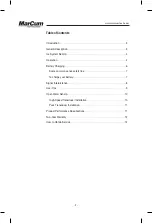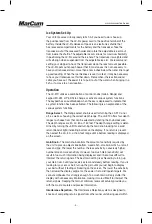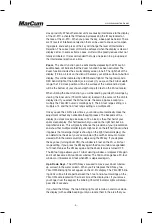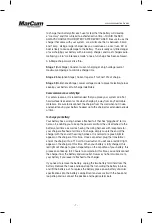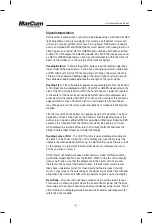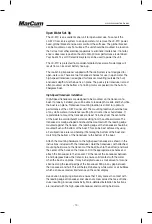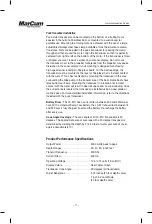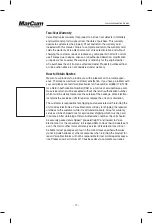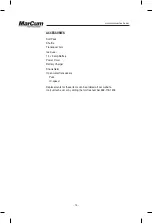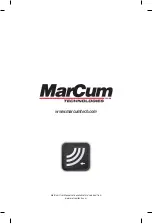
www.marcumtech.com
- 9 -
User Tips
Reading Through Ice – The LX3-tc will provide accurate information reading
through ice providing the ice is reasonably clear. To check the depth through
the ice, wet the ice with water to improve the coupling of the transducer to the
ice. Drilling into the ice 1-2” before taking a reading may be necessary if the
surface of the ice is very rough, or if the ice is filled with air bubbles. Depths
and even the presence of fish can easily be determined without drilling holes,
therefore greatly reducing time and energy in locating your fishing spot.
Fine Tuning Gain Control - To adjust gain properly, lower your lure or bait
to within a foot of the bottom. Turn the Gain up or down until the lure or bait
shows as a steady Yellow light. You should be able to raise or lower the lure
in a jigging fashion without losing the signal. If the Gain (or sensitivity) is kept
to a minimum, you should be able to separate targets down to 2.15 inches
on the 20-foot scale. You may need to fine tune the gain each time you move
locations, depending on the depth and bottom composition.
Signal Interpretation - Sound waves emitted by the LX-3TC bounce off
targets and return with the strength of the targets’ density. Denser targets
return with a stronger signal, displayed as RED. Less-dense objects (small
fish) return a medium-strength signal, displayed as GREEN. The least dense
objects (weeds, bait-fish, lure) return a weak signal, displayed as YELLOW.
Objects on the edge of the sound cone may appear as YELLOW. A fish
moving through the cone may appear first as YELLOW then GREEN, then
RED, depending on its size and how close to the center of the cone it moves.
Using the Ice Transducer – When used in conjunction with the retract-
able pivoting transducer arm and rubber stopper, the LX3-tc transducer will
automatically level itself in your ice hole. To begin operation, simply insert
transducer cable into rubber stopper at desired depth. Extend transducer arm;
insert cable into open end of transducer arm, and allow the rubber stopper
to rest in the open end of the transducer arm. We recommend setting your
stopper to have the transducer down the least amount possible. The LX3-tc
puts out enough power that in most cases it is not necessary to have your
transducer down more than a few inches below the water line to get a good
reading. When the ice thickness is over two feet, it may be necessary to have
your transducer set farther down. Remember--the less transducer cable you
have out, the easier it is to pull it out of the water when bringing in a fish, or to
move to a new location.


